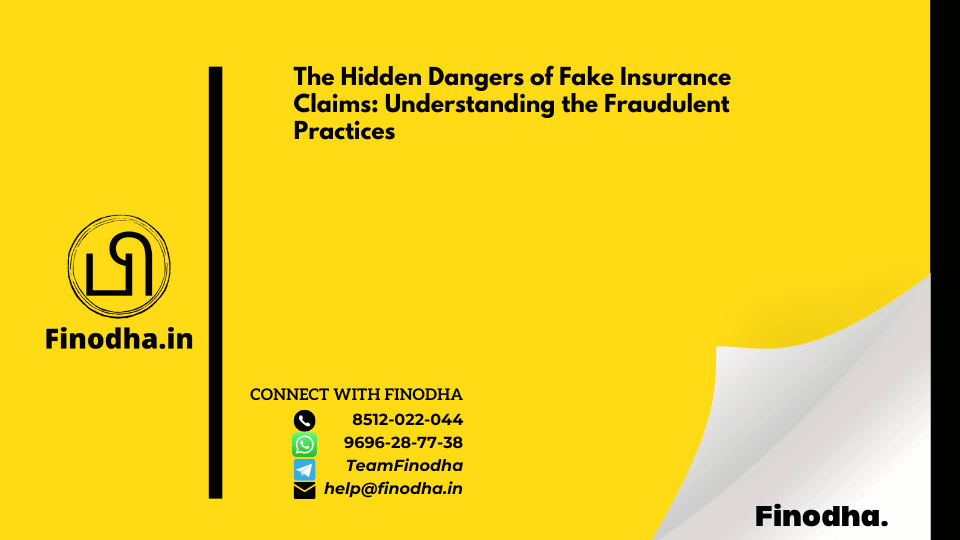Important keyword: Fake Insurance Claims, Insurance Fraud Detection, Consequences of Fraudulent Claims, Insurance Claim Investigation.
Table of Contents

Introduction to Fake Claims
Fake insurance claims refer to false statements made by policyholders with the intent to defraud insurance companies. These claims may involve exaggerating damages, fabricating incidents, or submitting completely bogus claims for financial gain. The motivations behind these fraudulent practices can vary, from a desire for quick monetary benefits to attempting to evade responsibility for personal negligence. Regardless of the intent, the repercussions of such actions resonate throughout the insurance sector and beyond.
For insurance companies, fake claims can have severe financial implications. These organizations rely on accurate data to assess risk and set premiums. When false claims proliferate, they distort loss ratios and threaten the overall solvency of insurance operations. In turn, these companies might respond by increasing premium rates for honest policyholders. Consequently, the detrimental impacts of fraudulent claims extend to individuals and communities, as everyone ultimately bears the financial burden of deceitful practices.
Furthermore, fake claims can erode the trust that defines the relationship between insurers and their customers. When people exploit the system, it results in a higher scrutiny of legitimate claims, leading to delays and, for some, denial of valid insurance requests. The psychological impact on honest policyholders can be profound; they may feel victimized a second time when their genuine claims are met with skepticism due to the taint of fraud in the industry.
It is crucial to understand that engaging in fake insurance claims is illegal and unethical. Insurance fraud can lead to severe penalties, including fines and imprisonment, highlighting the importance of maintaining integrity within the system. Recognizing the seriousness of this issue is essential not only for policyholders but also for insurers, as it helps to foster a fair and equitable market environment.
Understanding Fake Claims
Fake insurance claims, commonly recognized as fraudulent claims, represent a significant issue within the insurance industry, leading to substantial financial losses for providers and higher premiums for honest policyholders. A fake claim typically arises when an individual intentionally misrepresents or exaggerates information to receive an undeserved payout. These practices can range from minor embellishments to far-reaching deceptions.
One notable example of a fraudulent practice is when a policyholder exaggerates the value of stolen items following a reported burglary. Imagine a homeowner who claims that a thief stole several high-value electronics and jewelry items, inflating their actual worth. In reality, the stolen items may only have had a small fraction of the reported value. When the insurance company investigates, discrepancies between the claimed values and market prices often surface, thereby exposing the fraudulent nature of the claim.
Other common instances of fake claims may include staged accidents, where individuals orchestrate collisions to claim medical costs or property damage that never occurred. For instance, two parties may agree to collide their vehicles at low speeds to simulate an accident and subsequently report injuries that are exaggerated or entirely fabricated. Such actions not only undermine the integrity of the insurance system but may also lead to legal ramifications for all parties involved.
It is crucial to differentiate legitimate claims from those that are deceptive. Legitimate insurance claims typically consist of fully transparent information, backed by evidence such as police reports, photographs, or professional assessments. By understanding the underlying motives of exaggeration and deceit in fake claims, individuals can foster greater awareness and vigilance against the detrimental effects of fraudulent activities within the insurance landscape.
How Insurers Detect Fake Claims
Insurance companies employ a variety of sophisticated methods to detect fraudulent claims, which have become increasingly essential in today’s job environment where fake claims can significantly affect their operations and profitability. One of the primary techniques involves analyzing patterns across claims submissions. Insurers utilize statistical algorithms to review large volumes of claims data, comparing it to historical data and industry standards. Any unusual patterns, such as a sudden surge in claims from a particular individual or community, might raise red flags, prompting further investigation.
Data analysis plays a crucial role in identifying anomalies and inconsistencies in claims. Insurers frequently access numerous databases to gather comprehensive information about policyholders. This can include credit history, prior claims history, and even social media activity. A claimant’s background can reveal discrepancies, such as claiming injury while engaging in strenuous activities captured on social media platforms. This wealth of data enables insurers to make informed decisions regarding the legitimacy of a claim, ensuring that they uphold the integrity of the insurance process.
Moreover, insurers often employ trained investigators to delve deeper into suspicious claims. These investigators may conduct interviews, surveillance, and gather evidence to either substantiate or disprove a claim’s validity. In some cases, insurers may collaborate with law enforcement agencies when fraud appears to be a criminal offense. The thorough review processes that insurance companies implement are paramount to maintaining trust and reliability within the insurance industry.
Through the combination of data analytics, pattern recognition, and investigative techniques, insurers are equipped to efficiently identify and combat fraudulent claims. This not only protects their financial interests but also upholds the integrity of the insurance system as a whole, providing reliable coverage for those who genuinely need it.
The Role of Investigation Units
In order to combat the growing prevalence of fraudulent insurance claims, many insurance companies have established specialized investigation units dedicated to identifying and preventing fraud. These units consist of a range of professionals, including seasoned investigators, forensic experts, and data analysts, all trained specifically in recognizing the signs of deceitful behavior and assessing the legitimacy of claims. The complexity of fraudulent schemes necessitates a multi-disciplinary approach, drawing on expertise from various fields to ensure that all angles are considered during investigations.
One of the primary techniques employed by these investigation units is the meticulous execution of background checks. Investigators utilize advanced data analytics and investigative tools to sift through claims. They often verify information against databases, track records, and previous claims history to identify discrepancies that may suggest fraudulent activity. This process involves cross-referencing the claimant’s information with known fraud patterns or red flags that are indicative of potential deceit.
Furthermore, the investigation units frequently collaborate with law enforcement agencies to address criminal aspects of fraud. When evidence of fraud is uncovered, these teams may work closely with local police or federal authorities to pursue legal action. This collaboration enhances the effectiveness of investigations, as it allows for a more comprehensive approach to tackling fraud on multiple levels. The partnership between insurance units and law enforcement underscores the seriousness of insurance fraud as a crime that not only affects the insurance company but also ultimately impacts consumers and honest policyholders through increased premiums.
In conclusion, insurance investigation units play a crucial role in the fight against fraudulent claims, utilizing a range of techniques and collaborating with law enforcement to tackle the multifaceted issue of insurance fraud. Their efforts help maintain the integrity of the insurance industry and ensure that resources are utilized effectively to assist those with legitimate claims.
Consequences of Filing Fake Claims
Engaging in fraudulent activities within the insurance realm can attract severe legal and financial repercussions for policyholders. One of the primary outcomes of filing fake insurance claims is the potential for hefty fines imposed by regulatory authorities. Insurance fraud is viewed as a serious crime, and those caught attempting to deceive insurance companies can face penalties ranging from thousands to hundreds of thousands of dollars, depending on the scale and severity of the fraudulent act.
Moreover, individuals found guilty of submitting false claims may be subjected to imprisonment. Sentences for insurance fraud can vary significantly; however, in some jurisdictions, offenders could face years behind bars. This legal action not only disrupts personal lives but also establishes a permanent record that can affect employment opportunities and other aspects of an individual’s future.
Beyond legal consequences, individuals risking their integrity through such conduct may also experience the loss of their insurance coverage. Insurance providers frequently terminate policies if they discover that a claim has been filed fraudulently. This loss of coverage can lead to difficulties in obtaining new policies in the future, as insurance companies often label applicants with a history of dishonest claims as high-risk individuals. Consequently, this can result in increased premium rates or even outright denial of coverage.
Additionally, the implications extend beyond the individual, contributing to higher overall costs for honest policyholders. Insurers often pass on the costs associated with fraudulent claims through raised premiums, affecting all clients within the system. It is essential to understand the gravity of fake insurance claims and to recognize that honesty and transparency in dealings with insurance providers can foster a more trustworthy environment for everyone involved.An ethical approach not only safeguards individuals from dire consequences but strengthens the integrity of the insurance industry as a whole.
Real-Life Example: A Case of Exaggeration
Consider the case of Rajesh, a small business owner in a bustling neighborhood of Mumbai. One evening, his shop was reportedly broken into, and he claimed that a substantial amount of cash along with various electronics had been taken. He immediately filed an insurance claim, depicting a scenario where he suffered significant financial loss. However, upon further investigation, the true extent of the loss revealed discrepancies between Rajesh’s claims and the available evidence.
Initially, Rajesh claimed that approximately INR 5 lakhs in cash and goods had been stolen. He presented an assortment of receipts and photographs to support his assertions. However, local law enforcement conducted a preliminary investigation that showed no forced entry, and the security footage from nearby shops did not capture any suspicious activity around his store. This led to the insurance company conducting its own inquiry, aiming to separate exaggeration from reality.
Upon close examination, it became evident that Rajesh had not accurately reflected his stock levels. The investigator discovered that the value of the actual lost items was only around INR 1.25 lakhs. Moreover, some items he included in his claim were never present in his inventory, demonstrating a classic case of exaggeration. As a result, his insurance claim was denied, and the guilty implication of fraud loomed over him.
This case highlights the risks associated with exaggerating loss in insurance claims. Fraudulent practices, like those undertaken by Rajesh, not only undermine the integrity of the insurance system but also lead to potential legal repercussions for individuals who pursue dishonest claims. Thus, it serves as a poignant reminder that authenticity and honesty in claims are crucial to maintaining the trust of both insurers and the insured alike.
Frequently Asked Questions
Understanding fake insurance claims is crucial for both consumers and insurers alike. One common question is: what is the difference between exaggeration and fraud? Exaggeration involves inflating the details of a legitimate claim, while fraud entails making a claim for an event that never occurred or is entirely fabricated. Recognizing this distinction is essential, as the consequences for fraud are significantly more severe, often resulting in legal action and denial of coverage.
If you suspect someone is making a fake insurance claim, it is important to address the matter carefully. Start by gathering any evidence that supports your suspicions, such as discrepancies in the reported incident or patterns of behavior that seem suspicious. You should then report your concerns to the insurance company. Most insurers have dedicated fraud detection units that investigate claims and can take appropriate actions based on your information. Speaking up could potentially save others from the repercussions of fraudulent practices.
Another frequently asked question pertains to how insurers respond to fake claims. Insurance companies have sophisticated systems in place to detect fraudulent claims. These may include data analysis techniques, claim history reviews, and even surveillance in certain cases. When a claim is flagged as suspicious, the insurer may conduct a thorough investigation, which can include contacting witnesses, reviewing police reports, and analyzing any photographic evidence submitted. If fraud is confirmed, the insurer will not only deny the claim but may also take legal steps against the individual involved.
In navigating the complexities of insurance, understanding the nuances of fake claims and the associated processes can empower consumers to act responsibly and ethically, while also protecting the integrity of the insurance system.
Key Takeaways and Insights
The subject of fraudulent insurance claims unveils a multitude of complexities that extend beyond mere deception. As observed throughout our discussion, such behaviors not only risk the integrity of the insurance sector but also evoke severe consequences for the individuals involved. Understanding the intricate patterns of fake insurance claims is essential to fostering integrity within this essential service.
Firstly, it is crucial to acknowledge that honesty in insurance dealings significantly affects premiums and overall market stability. When individuals file false claims, they contribute to inflated costs, which ultimately impact honest policyholders. This environment of mistrust can lead to stricter regulations and higher deductibles, creating an adverse cycle that punishes genuine claimants.
Secondly, the legal repercussions of engaging in insurance fraud can be profound. Individuals caught participating in fraudulent activities may face hefty fines, restitution, and even imprisonment. Beyond the immediate penalties, the stigma surrounding fraud can tarnish a person’s reputation and hinder future financial opportunities, making it essential to consider the long-term implications of dishonest behavior.
Moreover, technological advancements in data analysis are transforming the insurance landscape, making it increasingly difficult for fraudsters to evade detection. Insurance companies are continually enhancing their investigative methods, utilizing sophisticated algorithms to identify suspicious patterns and behaviors. This evolution underscores the importance of transparency and honesty in all insurance dealings.
Ultimately, fostering a culture of integrity is vital for the insurance industry and its consumers. By understanding the potential repercussions of fake claims and adopting a responsible approach to insurance, individuals can contribute to a healthier, more reliable marketplace. Maintaining ethical standards not only protects oneself but also upholds the dignity and trustworthiness of the insurance profession as a whole.
Conclusion: A Call for Integrity in Insurance Claims
As we reflect on the complexities surrounding fake insurance claims, it becomes apparent that the repercussions extend beyond individual policyholders. The integrity of the insurance system is at stake, impacting not only the companies involved but also the broader societal trust in insurance as a safety net. The fraudulent practices associated with fake claims undermine the essence of insurance, which is to provide protection against unforeseen risks and losses. When integrity is compromised, the financial burden is often passed on to honest policyholders through increased premiums and restricted coverage options.
Both policyholders and insurers share a collective responsibility in maintaining a fair and trustworthy insurance landscape. Policyholders must approach their claims with honesty, understanding that integrity is vital to the sustainability of the insurance system. Dishonesty can lead to severe consequences, including legal repercussions and a permanent mark on one’s insurance history, which could hinder future coverage opportunities. Similarly, insurers play a crucial role in promoting ethical practices by implementing robust policies and compliance measures that discourage fraudulent activities.
To foster an environment of trust, the insurance industry must prioritize transparent communication and education for policyholders regarding the ramifications of fraud. Encouraging an open dialogue about the importance of ethical practices in claims processing can help mitigate instances of dishonesty. Furthermore, involving stakeholders in initiatives that promote integrity can strengthen relationships between insurers and policyholders, creating a fair and equitable claims process for all.
In conclusion, cultivating integrity in the realm of insurance claims is imperative for protecting the integrity of the industry itself. As we navigate the intricate landscape of insurance, let us strive to prioritize honesty and fairness, ensuring that the system works for everyone involved.
Download Pdf: https://taxinformation.cbic.gov.in/





0 Comments